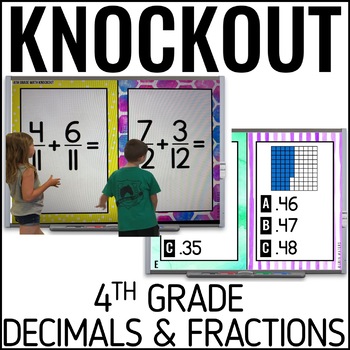4th Grade Decimal Games - 4th Grade Fraction Games - Fraction Knockout
- Zip
What educators are saying
Products in this Bundle (2)
Also included in
- This quick-paced, nail-biter of a classroom game will leave your kids BEGGING for more! Team up to knock out the other team's player. The last team standing wins! This is by far the most engaging thing I've done for my classroom this year. My kids get SO excited when we play, and they work super harPrice $698.75Original Price $1397.75Save $699.00
- This quick-paced, nail-biter of a classroom math game will leave your kids BEGGING for more! Team up to knock out the other team's player. The last team standing wins! This is by far the most engaging thing I've done for my classroom this year. My kids get SO excited when we play, and they work supePrice $606.38Original Price $1212.75Save $606.37
Description
This decimal and fraction game bundle includes 4th grade decimal and 4th grade fraction Knockout games. There are 27 games in all:
Fraction Games:
• Equivalent fraction models
• Adding proper fractions & mixed numbers [Like denominators]
• Multiplication and repeated addition of fractions
• Decomposing fractions
• Adding and subtracting unlike denominators [Solutions less than 1]
• Comparing improper fractions and mixed numbers
• Writing fractions as decimals
• Equivalent fractions [Denominators 10 and 100]
• Adding fractions [Denominators 10 and 100]
• Multiplying whole #'s by fractions
• Adding and subtracting like denominators [Solutions less than 1]
• Comparing fractions
• Converting mixed numbers to improper fractions
• Subtracting fractions and mixed numbers [Like denominators]
• Converting improper fractions to mixed numbers
• Adding fractions with unlike denominators [Solutions greater than 1]
Decimal Games:
• Converting Decimals to Fractions [Tenths]
• Converting Decimals to Fractions [Hundredths]
• Converting Fractions to Decimals [Tenths]
• Converting Fractions to Decimals [Hundredths]
• Adding Fractions [Sums as Decimals]
• Comparing Decimals [Hundredths]
• Comparing Decimals [Tenths]
• Decimal Models [Hundredths]
• Decimal Models [Tenths]
• Decimals on a Number Line [Tenths]
• Decimals on a Number Line [Hundredths]
Thanks for visiting my store! I hope you come again soon :)
Erin Waters
Elementary Education




